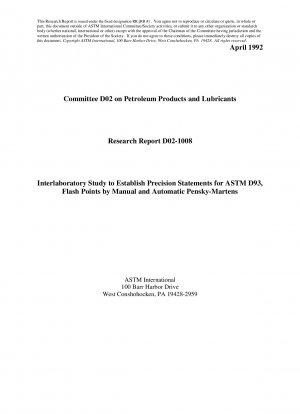ASTM RR-D02-1008 1992
D0092-Test Method for Flash and Fire Points by Cleveland Open Cup Tester
- Standard No.
- ASTM RR-D02-1008 1992
- Release Date
- 1970
- Published By
- /
- Scope
- I.I These test methods cover the determination of the flash point by Pensky-Martens dosed-cup tester or fuel oils, lube oils, suspensions of solids, liquids that tend to form a surface film under test conditions, and other liquids of similar viscosities. NOTE I—This lest method CM be employed for the detection of contamination of lubricating oils by tninor imounti of volatile materials. Norc 2—The VS. Department of Traastmtatioa (DOT)* md VS. Department of Ubor (OSHA) have ewiNished that liquids with a fash point under IOOT (37JTC, are Oammabk at determined by methods for thoscliquio^wiiichhaveavrKMryof}.lcSlornMircat IOOT(37TO or 9.J cSt or more at 7TT (2TQ. or that contain luaniwhrl solids, or have a tendency to fonn a surface film while under test. Other Classification flash points have been established by these departments for liquids using this test. These regulations are ia degrees Fahrenheit. 1.2 Liquids having viscosities less than 5.5 cSt at 40*C (KMT) do not contain suspended solids or do not have a tendency to form a surface film while under test conditions can be tested in accordance with Test Method D 56. 1.3 The values stated in SI units shall be retarded as the ■ methods are under the jurisdinic* of ASTM Committee D-2 oa Petroleum Products and Lubricants and arc the direct mpuiauihi) of Subcommittee D02.M on Volatility In the IP, that methods art under the ninadicuoa of the Standardization Committee. Current edition approved Oct. 36. 1990. Published December 1990. OritmaHy published as D 9} 21 T. Last previous edition 093 -15. 1 For information concemins refutations of VS. Department of Transportation, ice Codes ofVS. Refutations 49 CFR. Chapter I. and of US. Department of Labor, set 29 CFR. Chapter XVII. Each of these items a revised annually and may be procured from Superintendent of Documents. Government Pnntinf Office. Washington. DC 20402. standard. The values given in parentheses are for information only. 1.4 This standard should be used to measure and describe the properties of materials, products, or assemblies in response to heat andJlame under controlled laboratory conditions and should not be used to describe or appraise thefire hazard or fire risk ofmaterials, products, or assemblies under actual fire conditions. However, results of this test may be used as elements ofa fire risk assessment which takes into account all of the factors which are pertinent to an assessment ofthefire hazard ofa particular end use. 1.5 This standard does not purport to address all of the safetyproblems associated with its use. It is the responsibility of the user ofthis standardto establish appropriate safety and health practices and determine the applicability ofregulatory limitations prior to use. For specific hazards statements, see Section 7 and Note 5. 1.1 These test methods cover the determination of the flash point by Pensky-Martens closed-cup tester of fuel oils, lube oils, suspensions of solids, liquids that tend to form a surface film under test conditions, and other liquids of similar viscosities. NOTE I—This leu method can be employed lor the detection of contamination of lubricating oils by minor ■mnaitM of volatile materials. NOTE 2—The VS. Department of Tratavonation (DOT)* and US. Department of Labor (OSHA) have esublished thM liqiads with a flam point under lOPF(37.S^arei1ammabkasote those liquids which tavea vcHotity of S.I cSi or more at I00T(37JD or 9.5 cSt or more at 7TT (23D. or that contain suspended tohds. or have a tendency to form a surface film while under sen. Other destination flash points have been established by these depanmenu tor liquids using this test. These regulations are in dearea Fahrenheit. 1.2 Liquids having viscosities less than 5.5 cSt at 40*C (I04*F) do not contain suspended solids or do not have a tendency to form a surface film while under test conditions can be tested in accordance with Test Method D 36. 1.3 The values stated in SI units shall be regarded as the a methods are under the jurisdicuoa of ASTM Committee D»2 oa Petroleum Products and Lubncaats and are the direct invunabiln» of Subcommtnee D02.0S on Volatility. la the IP. these methods ant under the junadicuoa of the Suadarduation Cbmnutsse. Current edition approved On. 36. 1990. Published December 1990. OnpnaMy published as O 9J 21 T. Last previous edition 093 -13. ' For information conccrmog refutations of VS. Department of Transportation, tec Codes ofUS. Regulations 49 CFK Chapter I. and of US. Department of Labor, see 29 CFR. Chapter XVII. Each ofthese items is revised annually and may be procured from Superintendent of Documents. Government Printing Office. Washington. DC 20402. standard. The values given in parentheses are for information only. 1.4 This standard should be used to measure and describe the properties of materials, products, or assemblies in response to heat andflame under controlled laboratory conditions and should not be used to describe or appraise thefire hazardorfire risk ofmaterials, products, or assemblies under actual fire conditions. However, results of this test may be used as elements ofa fire risk assessment which takes into account all of the factors which arepertinent to an assessment ofthefire hazard ofa particular end use. 1.5 This standard does not purport to address all of the safetyproblems associated with its use. It is the raponsiMiiy of the user ofthis standardto establish appropriate safety and health practices and determine the applicability ofregulatory limitations prior to use. For specific hazards statements, see Section 7 and Note 3.
ASTM RR-D02-1008 1992 Referenced Document
- ASTM D1078 Standard Test Method for Distillation Range of Volatile Organic Liquids*, 1999-04-22 Update
- ASTM D56 Standard Test Method for Flash Point by Tag Closed Tester*, 1993-03-22 Update
- ASTM D850 Standard Test Method for Distillation of Industrial Aromatic Hydrocarbons and Related Materials*, 1999-04-22 Update
